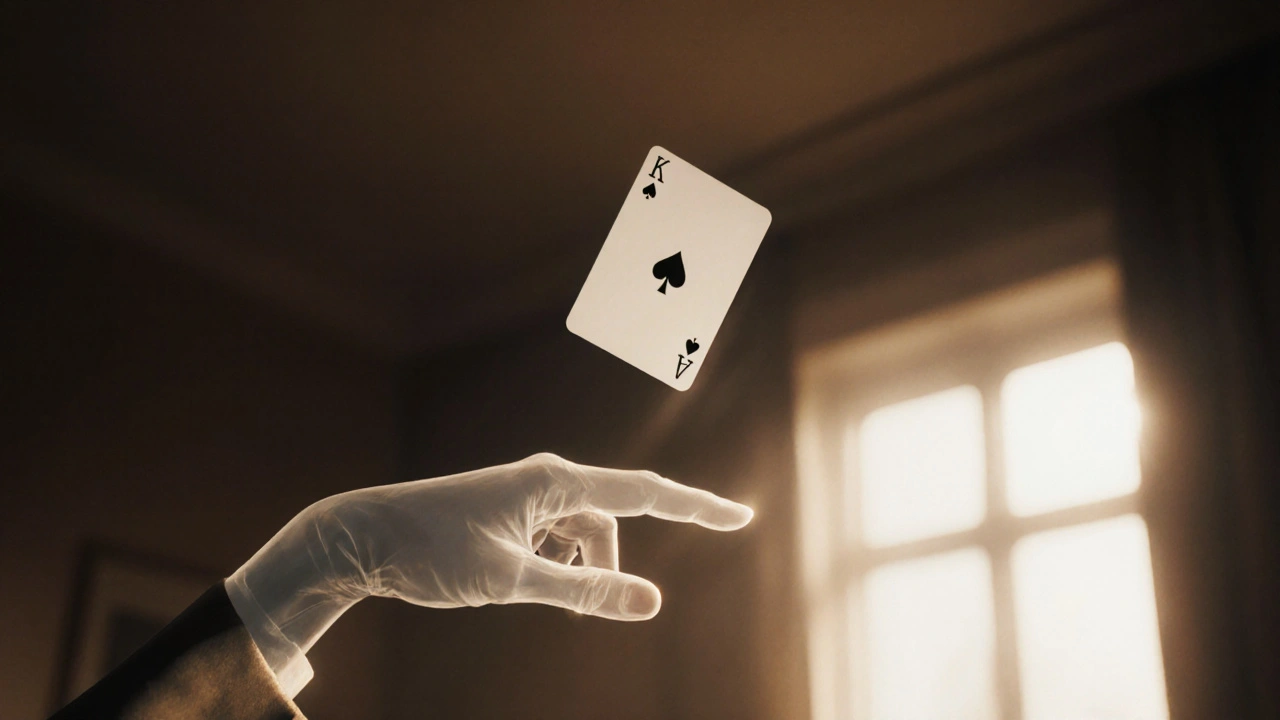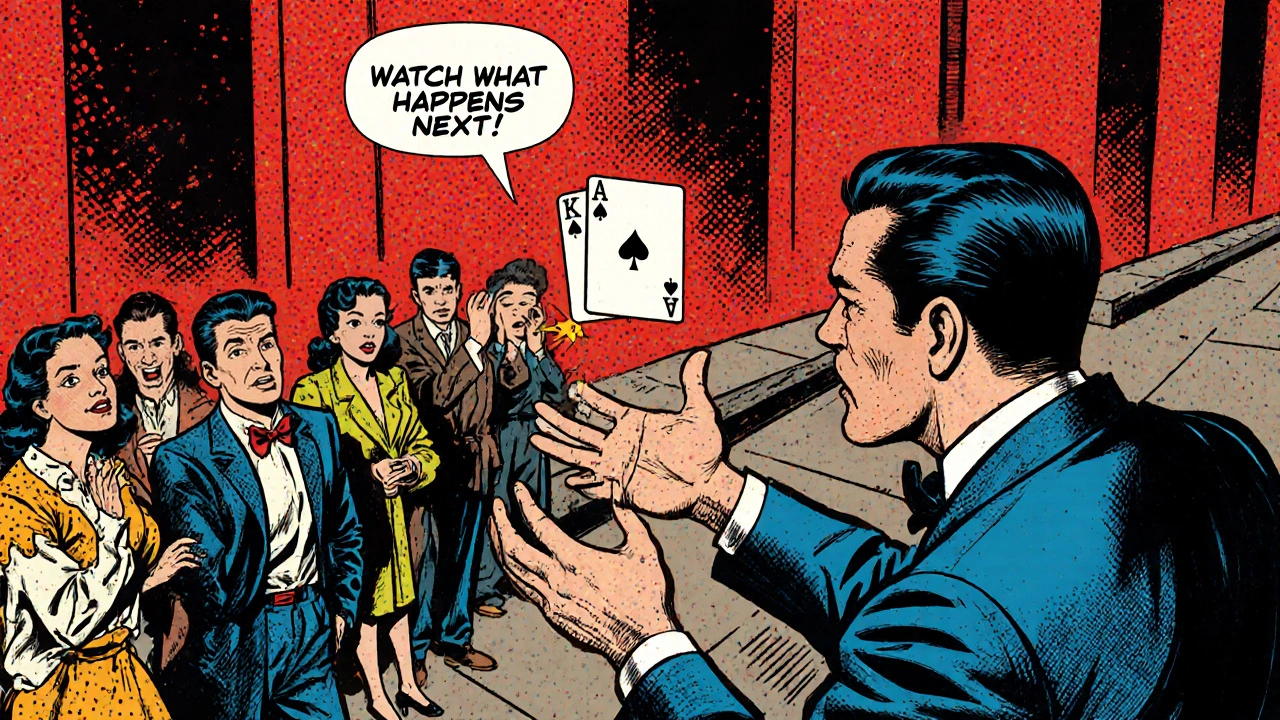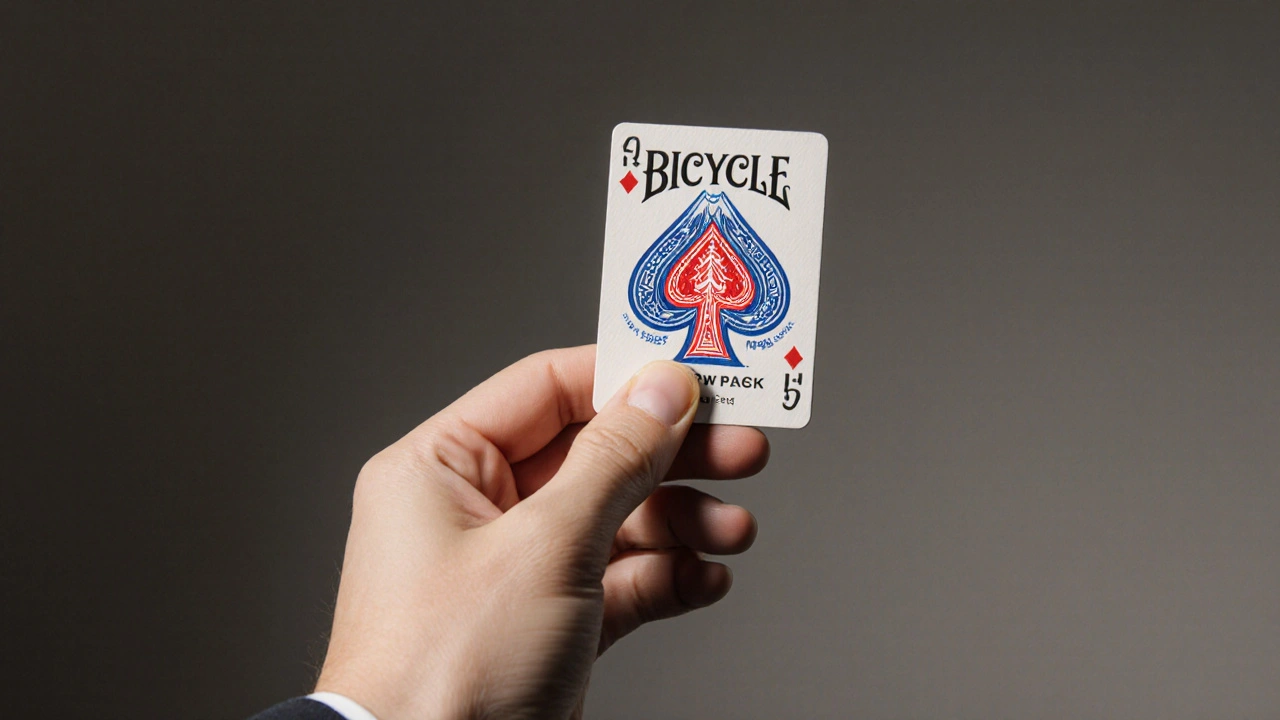Want to make a playing card float in midair like it’s defying gravity? It’s one of the most classic and mind-blowing magic tricks out there - and you don’t need fancy gear or years of practice to pull it off. The floating card illusion looks impossible, but it’s built on simple physics, misdirection, and a few well-placed hand movements. Once you get the hang of it, spectators will swear the card is suspended by magic. Here’s how to do it right - no gimmicks, no strings, just your hands and a standard deck.
What You’ll Need
You don’t need a special deck. Just grab any ordinary playing card - a standard poker-sized card from a brand like Bicycle or Bee works best. Avoid thin or flexible cards; they won’t hold their shape well. You also need a quiet room with good lighting. Too much background noise or dim light makes it harder to control the trick and easier for people to spot your moves.
Step 1: Master the Grip
The secret to the floating card isn’t in the card - it’s in how you hold it. Start by holding the card vertically between your thumb and the side of your index finger. Your thumb should rest on the top edge, and your index finger should press gently along the right side. The rest of your fingers curl slightly under the card, out of sight. This grip hides the fact that you’re pinching the card with your thumb and finger, not just holding it loosely.
Practice this grip until you can hold the card steady without shaking. Try holding it at eye level for 30 seconds. If the card wobbles, you’re using too much pressure. If it slips, you’re not holding it tight enough. The goal is a firm but relaxed grip that looks like you’re barely touching it.
Step 2: The Hidden Support
The floating effect comes from using your middle finger as a hidden support. While holding the card with your thumb and index finger, slide your middle finger up from underneath the card until its tip gently touches the bottom edge. Your middle finger should be bent at the first joint, so the tip is barely visible - it looks like your hand is just resting naturally. This tiny contact point is all you need to lift and stabilize the card.
Most people think the card is floating because they don’t see anything holding it. But your middle finger is doing the work. It’s thin, fast, and positioned in the blind spot of the viewer’s vision. The key? Don’t move your middle finger. Let the card appear to float on its own. Any movement in that finger gives it away.
Step 3: The Lift and Slow Reveal
Now comes the performance. Hold the card at chest height, facing your audience. Keep your wrist relaxed. Slowly lift your hand upward, as if you’re gently pushing the card into the air. As you lift, slightly rotate your wrist so the card turns edge-on toward the audience. This angle hides your middle finger completely. The card should rise smoothly, like it’s being pulled by an invisible force.
Don’t rush. A slow, deliberate lift makes the illusion stronger. If you jerk the card up, people will think you’re using a thread or magnet. Take three full seconds to raise it to eye level. Pause for a beat. Let the audience stare. Then, slowly lower it back down - same motion, same control.

Step 4: Misdirection Is Everything
Even the best grip won’t work if your audience is watching your fingers. That’s where misdirection comes in. While lifting the card, make eye contact with someone in the front row. Smile. Say something casual like, “Watch what happens next,” or “I’m not touching it, I swear.”
People follow your gaze. When you look at them, they look at your face - not your hands. Even better, slightly tilt your head or shift your shoulder as you lift. These small movements draw attention away from your fingers. The more you act like you’re not doing anything, the more believable the trick becomes.
Step 5: Practice in Front of a Mirror
Do this every day for five minutes. Stand in front of a mirror and perform the trick. Watch your hands. Can you see your middle finger? If yes, adjust your grip. Is your thumb too visible? Tuck it in. Is the card tilting? Fix your wrist angle.
After a week of daily practice, try it in front of a friend who doesn’t know magic. Ask them to guess how it’s done. If they say “string,” “magnet,” or “video editing,” you’ve nailed it. If they say “your finger,” go back to the mirror. Keep refining.
Common Mistakes to Avoid
- Using a weak card: Thin or warped cards bend under pressure and look fake. Stick to standard poker cards.
- Moving your middle finger: Even a tiny twitch ruins the illusion. Keep it still like a statue.
- Rushing the lift: Speed kills magic. Slow is mysterious. Fast is suspicious.
- Looking at your hands: Always look at the audience, not the card. Your eyes tell them where to look.
- Doing it in bad light: Shadows or glare reveal hidden fingers. Do this in even, bright lighting.

Why This Trick Works So Well
The floating card plays on how our brains process motion and support. We assume that if something is floating, it must be suspended by something visible - a wire, a magnet, air pressure. But our brains don’t expect a finger to be supporting it from below, especially when it’s hidden in the natural curve of the hand. This is called “inattentional blindness.” You’re not hiding the finger - you’re making the audience forget to look for it.
Magicians like David Blaine and Dynamo have used variations of this trick in street performances. It works because it’s simple, silent, and requires no props. All you need is your hands and a deck of cards.
Advanced Tips for Better Performance
- Use a card with a design: Cards with bold borders or patterns (like Bicycle Rider Backs) hide the edge of your finger better than plain white backs.
- Add a whisper: As you lift, whisper “lift” or “rise” under your breath. It primes the audience to expect movement - and makes them less likely to question how it’s happening.
- Do it while walking: Once you’re confident, try floating the card while taking a slow step forward. It adds drama and distracts from your hand position.
- Combine it with other tricks: After the float, make the card vanish or change color. The floating card sets up a sense of wonder that makes the next trick feel even more impossible.
Final Thought: It’s Not About Magic - It’s About Control
This trick isn’t magic. It’s physics. It’s psychology. It’s muscle memory. The card doesn’t float because of supernatural force - it floats because you’ve trained your hand to do something invisible. That’s what real magic is: making the ordinary feel extraordinary.
Practice until your fingers move without thinking. Then, when you perform it, you won’t be doing a trick - you’ll be creating a moment of wonder. And that’s worth more than any gimmick.
Can I use any type of playing card for this trick?
You can use any standard poker-sized playing card, but thicker, stiffer cards like Bicycle or Bee work best. Thin or flexible cards bend too easily and won’t hold their shape when lifted. Avoid novelty cards or plastic-coated cards - they’re too slippery and don’t respond well to subtle finger pressure.
Do I need to use my middle finger? Can I use another finger?
The middle finger is ideal because it’s the right length and thickness to support the card without being obvious. Your ring finger is too short and weak. Your index finger is already used for gripping. Your thumb is too thick and visible. The middle finger fits perfectly in the natural curve of your hand, making it the only practical choice for this trick.
Why does the card look like it’s floating even though my finger is touching it?
Your middle finger is hidden in the blind spot of the viewer’s vision - the area your brain ignores when focusing on the card. People expect to see support from above or behind, not from below. When your finger is bent and tucked, it blends into the natural shape of your hand. Your brain fills in the gap and assumes nothing is holding the card.
How long does it take to learn this trick?
Most people can get the basic motion down in one evening with focused practice. But to make it look smooth and convincing, plan on 5-7 days of daily 10-minute sessions. The real test is performing it in front of someone who doesn’t know magic - if they’re truly fooled, you’ve mastered it.
Can I do this trick while standing or walking?
Yes - once you’re comfortable with the grip and lift, you can do the trick while standing, walking slowly, or even turning slightly. The key is keeping your hand steady and your movements smooth. Walking adds drama and distracts the audience, making it harder for them to focus on your fingers. Just avoid sudden movements or jerks.


Aimee Quenneville
November 5, 2025 AT 09:33Angelina Jefary
November 5, 2025 AT 20:11Cynthia Lamont
November 7, 2025 AT 07:39Jennifer Kaiser
November 7, 2025 AT 15:09Jasmine Oey
November 9, 2025 AT 13:06Morgan ODonnell
November 11, 2025 AT 09:44James Winter
November 12, 2025 AT 07:09Kirk Doherty
November 13, 2025 AT 02:04Marissa Martin
November 13, 2025 AT 19:37Dmitriy Fedoseff
November 15, 2025 AT 08:42Meghan O'Connor
November 15, 2025 AT 12:49TIARA SUKMA UTAMA
November 15, 2025 AT 13:36